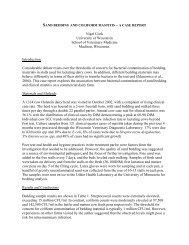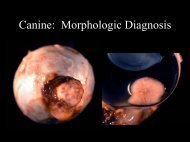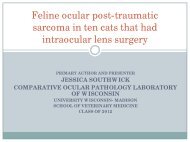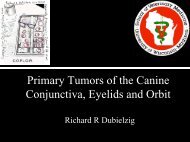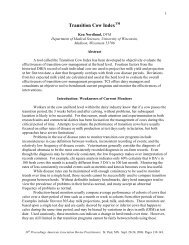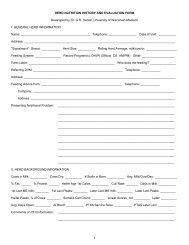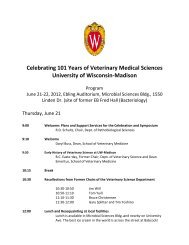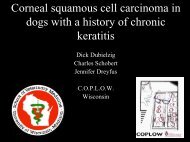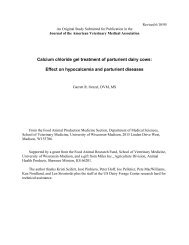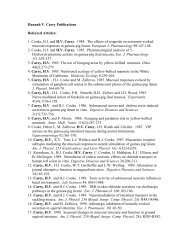Subacute Ruminal Acidosis in Dairy Herds - University of Wisconsin ...
Subacute Ruminal Acidosis in Dairy Herds - University of Wisconsin ...
Subacute Ruminal Acidosis in Dairy Herds - University of Wisconsin ...
You also want an ePaper? Increase the reach of your titles
YUMPU automatically turns print PDFs into web optimized ePapers that Google loves.
Preconvention Sem<strong>in</strong>ar 7A: <strong>Dairy</strong> Herd Problem Investigation Strategies:Lameness, Cow Comfort, and <strong>Rum<strong>in</strong>al</strong> <strong>Acidosis</strong>The degree <strong>of</strong> escape <strong>of</strong> trans fatty acids from the rumen depends largely on the amounts <strong>of</strong>their unsaturated fat precursors (18:2 and 18:3 fatty acids) are present <strong>in</strong> the diet. High rates <strong>of</strong>passage also contribute to more escape <strong>of</strong> these fatty acids to the rumen. These fatty acids do nothave detrimental health effects themselves; thus, it is possible for a herd to have milk fatdepression without cow health problems.The potential for plant source fats to cause milk fat depression depends on both their content<strong>of</strong> unsaturated fatty acids (see Table 5) and on their rate <strong>of</strong> release <strong>in</strong> the rumen. Slowly releasedplant fat sources such as whole cottonseeds present much less risk for milk fat depression than dorapidly released plant fat sources such as wet distillers gra<strong>in</strong>s.Table 5. Typical Fatty Acid Analysis <strong>of</strong> Fats and OilsFatty Acid Corn Cottonseed Lard Canola Soybean TallowC14-1 (Myristic) 1.0 1.5 3.0C16 (Palmitic) 12.5 26.0 27.0 4.0 11.5 25.0C16-1 (Palmitoleic) 1.0 3.0 2.5C17 (Margaric) .5 1.5C18 (Stearic) 2.5 3.0 13.5 2.0 4.0 21.5C18-1 (Oleic) 29.0 17.5 43.4 60.0 24.5 42.0C18-2 (L<strong>in</strong>oleic) 55.0 51.5 10.5 20.0 53.0 3.0C18-3 (L<strong>in</strong>olenic) .5 .5 10.0 7.0C20 and over 4.0Unsat/Sat Ratio 5.7 2.2 1.4 15.7 5.5 1.0Animal source fats or rum<strong>in</strong>al by-pass fats pose little risk for <strong>in</strong>complete biohydrogenationand milk fat depression (Figure 11). Rather, the risk with these fats can be reduced total tractdigestibility as they by-pass not only the rumen, but the entire digestive tract as well.Monens<strong>in</strong> supplementation may contribute to milk fat depression. Supplement<strong>in</strong>g monens<strong>in</strong>on the high end <strong>of</strong> the dosage range (16 to 24 ppm – the same as 15 to 22 grams per ton)depresses milk fat percentage about .1 to .2%. The degree <strong>of</strong> depression may wane as themonens<strong>in</strong> if fed for a longer time period. Monens<strong>in</strong> feed<strong>in</strong>g appears to <strong>in</strong>teract with excessivefeed<strong>in</strong>g <strong>of</strong> unsaturated fats and rum<strong>in</strong>al acidosis to cause milk fat depression. Interest<strong>in</strong>gly,monens<strong>in</strong> helps prevent rum<strong>in</strong>al acidosis (probably by <strong>in</strong>hibit<strong>in</strong>g lactate producers and favor<strong>in</strong>glactate utilizers), yet still has the overall effect <strong>of</strong> reduc<strong>in</strong>g milk fat percentage. If a herdexperiences noticeable milk fat depression soon after start<strong>in</strong>g to feed monens<strong>in</strong>, it is better to<strong>in</strong>vestigate and correct other causes <strong>of</strong> the milk fat depression rather than to automaticallyremove the monens<strong>in</strong> from the diet.<strong>University</strong> <strong>of</strong> Wiscons<strong>in</strong>, School <strong>of</strong> Veter<strong>in</strong>ary Medic<strong>in</strong>e, 2015 L<strong>in</strong>den Drive, Madison, WI 53706102



